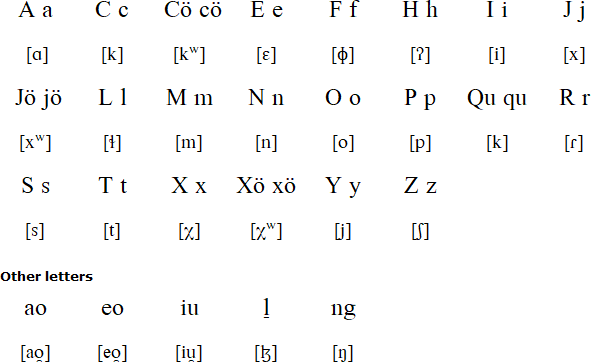Seri is a language isolate spoken by about a thousand people in two villages on the coast of Sonora in northern Mexico. The native name for the language, cmiique iitom, means "(that) with which a Seri person speaks". The language has also been called kunkaak, a version of the native name for the Seri people, comcaac. The origins of the name Seri are uncertain but are thought to come from another language in the region.
Seri is thought to be the last surviving member of its language family and nothing is know of the other members. Efforts to find links between Seri and other languages, such as the Hokan, Pomoan and Chontal languages, have produced no clear evidence of connections.
The Seri alphabet was developed in the 1950s by Edward W. and Mary B. Moser, American linguists working for the Summer Institute of Linguistics (SIL), and later revised by Stephen Marlett, a linguist who also works for SIL, and Seri speakers.
The first Seri wordlist was collected in the 1850s when the language was believed to be a dialect of Arabic, and since the 1950s some stories have been published, the New Testament has been translated, and a number of other publications in Seri have appeared.

Download an alphabet chart for Seri (Excel)
Heeesam quij toc cömiij. Coote hapah quij toc cömiij. Coteexoj hapah quij toc cömiij. Heem hapah quij toc cömiij. Xaasj himcap toc cömiip. Mojepe quih toc cömiip. Taax toc cömotat ma, heeesam quih toc cömiih. Tiix mos tcmiiquet, toc cöquiihtim iha.
From: Heeesam quih xepe an hant cöiyaait hac, by Jesús Morales, tiix oaah iha
Seahorse was there (as a person, on the earth). What is called teddybear cactus was there. What is called cholla was there. What is called pencil cholla was there. The sagueso cactus was there. The saguaro cactus was there. Those were coming there, the seahorse was there. He also was a person there.
Source: http://lengamer.org
Information about Seri language
http://www.sil.org/mexico/seri/00i-seri.htm
http://en.wikipedia.org/wiki/Seri_language
http://www.und.nodak.edu/instruct/smarlett/Documents/whyinteresting.html
Adaizan, Ainu, Basque, Burushaski, Candoshi-Shapra, Chitimacha, Eskayan, Hadza, Haida, Karuk, Kawésqar, Keres, Kuot, Kusunda, Kutenai, Natchez, Nihali, Nivkh, Páez, Purepecha, Sandawe, Seri, Sumerian, Tartessian, Ticuna, Tiwi, Tonkawa, Tunica, Urarina, Waorani, Warao, Wardaman, Washo, Yaghan, Yele, Yuchi/Euchee, Zuni
Languages written with the Latin alphabet
Page last modified: 28.02.22
[top]
You can support this site by Buying Me A Coffee, and if you like what you see on this page, you can use the buttons below to share it with people you know.

If you like this site and find it useful, you can support it by making a donation via PayPal or Patreon, or by contributing in other ways. Omniglot is how I make my living.
Note: all links on this site to Amazon.com, Amazon.co.uk
and Amazon.fr
are affiliate links. This means I earn a commission if you click on any of them and buy something. So by clicking on these links you can help to support this site.
[top]